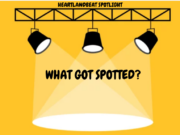Upcoming Events:
Mar. 19: Kiwanis and SCCDP Ag Banquet, 5:30 p.m. Social, 6:30 p.m. Meal, 7 p.m.Program, Fairgrounds, Seward, Tickets $25:  402-643-3636
Mar. 19:  Agriculture Seminar Series, 6-7 p.m., Mid-Plains Community College, McCook, 308-345-8122
Mar. 21:  V6 Cover Crop Field Day, 1:30-3:30 p.m., 4th Ave and 1/4 mile north on Arthur Road near St. Libory, NE, RSVP Dean Krull:  dkrull1@unl.edu
Mar. 24:  Introductory (Year 2) Beekeeping, 9 a.m.-4 p.m., UNL Eastern Nebraska Research and Extension Center (Formerly ARDC), Mead, NE
Apr. 3-5:  Our Farms, Our Future Sustainable Ag Conference, St. Louis, MO, https://ofof.sare.org/
Apr. 4:  Capturing Value in Cropping Systems Using Cattle, 9-4 p.m., ENREC near Mead
Apr. 4-5:Â Â Connecting Entrepreneurial Communities, Hastings, NE
Apr. 4-6:Â Nebraska State FFA Convention, Lincoln
May 9:Â Introductory Level Field Scout Training, ENREC near Mead
May 22-23:  Tractor Safety Training, Fairgrounds, Geneva, (402) 759-3712
May 24-25:  Tractor Safety Training, Fairgrounds, Hastings, (402) 461-7209
May 29-20:  Tractor Safety Training, Fairgrounds, Kearney, (308) 236-1235
June 28:Â South Central Ag Lab Weed Science & Cover Crop Field Day, Clay Center
Aug. 22:Â Â Soybean Production Clinic, ENREC near Mead
Aug. 23:Â Corn Production Clinic, ENREC near Mead
Crop Insurance and Tax Information:  This week’s UNL CropWatch at http://cropwatch.unl.edu has several timely articles regarding crop insurance and tax information. Please be sure to check them out!
Wheat Stem Maggot Webinar: For those of you with small grain cover crops with plans to plant corn into them, a reminder of the wheat stem maggot webinar we’re having this Wednesday, March 14 from Noon-1 p.m. CST. The webinar link to join is:  https://unl.zoom.us/j/976118766. There’s also an article from Dr. Justin McMechan, who will also be presenting the webinar, in this week’s CropWatch regarding reasons to not use an insecticide application during time of termination. Basically he and Dr. Bob Wright share that in doing so, there’s no guarantee the wheat stem maggot is present and one may just kill off beneficial insects. Instead, it’s encouraged to scout fields for the wheat stem maggot adults or larvae. There’s also not good data regarding when the maggots leave the cover crop and move into the wheat; thus, it’s hard to ensure an insecticide will have enough residual for that time period. Instead, they’re recommending if finding wheat stem maggots via scouting, to terminate the cover crop at least 14 days prior to planting. If weather or other circumstances don’t allow for that, they’re recommending to apply the insecticide around 11 days after the glyphosate application. This recommendation has been shown effective for common stalk borer and they’re hoping it may work for wheat stem maggot as well, but it’s not guaranteed. Justin and Bob will be sampling for the next several weeks and will continue to post updates to the CropWatch website, their Twitter and the CropWatch Twitter accounts.
Economics of Annual Forages Recording is now available for all who’ve been asking! You can find it at:  https://beef.unl.edu/economics-producing-forage-cropland along with excel spreadsheets and resources mentioned in the webinar. While this didn’t appear incredibly favorable with the scenarios presented, it’s encouraged to look at the numbers for your own operations. I still feel this can be economical/comparable when you look at scenarios of a few forage crops/year on a piece of ground and look at ways to spread out the cost of equipment (such as custom farming, etc.). When I was working on budgets with individual farmers, I didn’t account for fewer acres covered on the equipment dedicated to corn, so that’s where my numbers differed the most in addition to including the value of the cattle. As individuals, you can be more specific for your operations than they could do in the scenarios that were being generalized for the purposes of the webinar. I still think this is something for consideration, especially if you have cattle and own ground. With Nebraska being surrounded by drought in states around us, it may be helpful to have some additional feed grown this year.
Frogeye Leaf Spot Fungicide Resistance in Iowa: For those of you who’ve attended my pesticide trainings, I spend time on resistance management because it’s so important. I had mentioned that Cercospora sojina that causes Frogeye leaf spot in soybean was found to be resistant to the strobilurin (quinone outside inhibitor Qol, Group 11) chemistry of fungicides in several Southern U.S. states. This winter, Iowa State and the University of Kentucky confirmed this resistance in Iowa as well. You can read the full article here:  https://crops.extension.iastate.edu/cropnews/2018/02/frogeye-leaf-spot-fungicide-resistance-confirmed-iowa-soybean.  This is a difficult situation because the strobilurin chemistry can be found in a number of fungicide products we use in corn, soybean, and wheat and has a high ability for fungal resistance to occur. Frogeye tends to occur more regularly in eastern Nebraska where there’s higher humidity.
I’ve been watching updates on this situation because Cercospora is the genus to which the fungus Cercospora zeae-maydis causing gray leaf spot in corn also belongs. We definitely don’t wish to see Cercospora zeae-maydis develop resistance to the strobilurin chemistries! Thus, besides the reason that Nebraska research doesn’t show an automatic yield response to fungicide application at tassel in corn, it’s also a resistance management strategy to not apply a fungicide unless you need it. The same goes for soybean and wheat; only use fungicides when we really need them in order to prolong their effectiveness against fungal pathogens.
Worker Protection Standard:  Also in pesticide training we shared updates to the Worker Protection Standard. This applies to those who hire workers or handlers in your operations (outside of immediate family members) when the Worker Protection Standard is mentioned on pesticide labels (often in the Agricultural Use Requirements section). The Pesticide Resources Educational Collaborative (PERC) has developed a library of information on their front page to make it easier to train workers/handlers. You can find these resources at:  http://www.pesticideresources.org/. There’s also a course by Certified Training Institute (CTI). You may have received a postcard from them in the mail regarding online private applicator training. Technically, they are not the only approved online training option for private applicator training in Nebraska as UNL also has an online training option for $60. But CTI also has an online training option for the Worker Protection Standard and cost varies depending on number of employees; UNL doesn’t have an online option for that. So you may wish to look them up if you don’t wish to do the training yourself or use the PERC website.
































